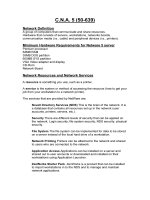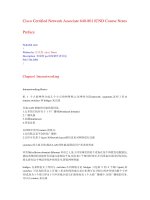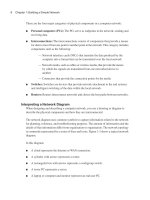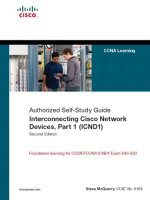Tài liệu Cisco.press.interconnecting.cisco.network.devices doc
Bạn đang xem bản rút gọn của tài liệu. Xem và tải ngay bản đầy đủ của tài liệu tại đây (3.19 MB, 407 trang )
800 East 96th Street
Indianapolis, Indiana 46240 USA
Cisco Press
Authorized Self-Study Guide
Interconnecting
Cisco Network Devices,
Part 2 (ICND2)
Steve McQuerry,
CCIE No. 6108
ii
Authorized Self-Study Guide
Interconnecting Cisco Network Devices, Part 2 (ICND2)
Steve McQuerry
Copyright© 2008 Cisco Systems, Inc.
Published by:
Cisco Press
800 East 96th Street
Indianapolis, IN 46240 USA
All rights reserved. No part of this book may be reproduced or transmitted in any form or by any means, electronic or
mechanical, including photocopying, recording, or by any information storage and retrieval system, without written
permission from the publisher, except for the inclusion of brief quotations in a review.
Printed in the United States of America
First Printing February 2008
Library of Congress Cataloging-in-Publication Data:
McQuerry, Steve.
Interconnecting Cisco network devices. Part 2 (ICND2) / Steve McQuerry.
p. cm.
ISBN 978-1-58705-463-1 (hardback)
1. Internetworking (Telecommunication)—Examinations—Study guides. 2. Computer networks—Problems,
exercises, etc. 3. Telecommunications engineers—Certification—Examinations—Study guides. I. Title.
TK5105.5.M33992 2008
004.6—dc22
2008000513
ISBN-13: 978-1-58705-463-1
ISBN-10: 1-58705-463-9
Warning and Disclaimer
This book is designed to provide information about the configuration and operation of Cisco routers and switches as
described in the Interconnecting Cisco Network Devices 2 (ICND2) course. Every effort has been made to make this
book as complete and as accurate as possible, but no warranty or fitness is implied.
The information is provided on an “as is” basis. The authors, Cisco Press, and Cisco Systems, Inc. shall have neither
liability nor responsibility to any person or entity with respect to any loss or damages arising from the information
contained in this book or from the use of the discs or programs that may accompany it.
The opinions expressed in this book belong to the author and are not necessarily those of Cisco Systems, Inc.
iii
Feedback Information
At Cisco Press, our goal is to create in-depth technical books of the highest quality and value. Each book is crafted
with care and precision, undergoing rigorous development that involves the unique expertise of members from the pro-
fessional technical community.
Readers’ feedback is a natural continuation of this process. If you have any comments regarding how we could
improve the quality of this book, or otherwise alter it to better suit your needs, you can contact us through email at
Please make sure to include the book title and ISBN in your message.
We greatly appreciate your assistance.
Corporate and Government Sales
The publisher offers excellent discounts on this book when ordered in quantity for bulk purchases or special sales,
which may include electronic versions and/or custom covers and content particular to your business, training goals,
marketing focus, and branding interests. For more information, please contact: U.S. Corporate and Government
Sales 1-800-382-3419
For sales outside the United States please contact: International Sales
Trademark Acknowledgments
All terms mentioned in this book that are known to be trademarks or service marks have been appropriately capital-
ized. Cisco Press or Cisco Systems, Inc., cannot attest to the accuracy of this information. Use of a term in this book
should not be regarded as affecting the validity of any trademark or service mark.
Publisher Paul Boger
Associate Publisher Dave Dusthimer
Cisco Representative Anthony Wolfenden
Cisco Press Program Manager Jeff Brady
Executive Editor Brett Bartow
Managing Editor Patrick Kanouse
Development Editor Deadline Driven Publishing
Senior Project Editor Tonya Simpson
Copy Editors Gill Editorial Services
Written Elegance, Inc.
Technical Editors Tami Day-Orsatti,
Andrew Whitaker
Editorial Assistant Vanessa Evans
Book and Cover Designer Louisa Adair
Composition ICC Macmillan, Inc.
Indexer Ken Johnson
Proofreader Language Logistics, LLC
iv
About the Author
Steve McQuerry, CCIE No. 6108, is a consulting systems engineer with Cisco focused on
data center architecture. Steve works with enterprise customers in the Midwestern United
States to help them plan their data center architectures. Steve has been an active member of
the internetworking community since 1991 and has held multiple certifications from
Novell, Microsoft, and Cisco. Before joining Cisco, Steve worked as an independent
contractor with Global Knowledge, where he taught and developed coursework around
Cisco technologies and certifications.
v
About the Technical Reviewers
Tami Day-Orsatti, CCSI, CCDP, CCNP, CISSP, MCT, MCSE 2000/2003: Security, is an
IT networking and security instructor for T
2
IT Training. She is responsible for the delivery
of authorized Cisco, (ISC)
2
, and Microsoft classes. She has more than 23 years in the IT
industry working with many different types of organizations (private business, city and
federal government, and DoD), providing project management and senior-level network
and security technical skills in the design and implementation of complex computing
environments.
Andrew Whitaker, M.Sc., CISSP, CCVP, CCNP, CCSP, CCNA, CCDA, MCSE, MCTS,
CNE, CEI, CEH, ECSA, Security+, A+, Network+, Convergence+, CTP, is the director of
Enterprise InfoSec and Networking for Training Camp, an international training company
that helps certify thousands of IT professionals each year through its unique accelerated
learning model. His expert teaching for Training Camp has garnered coverage by The Wall
Street Journal, The Philadelphia Inquirer, Certification Magazine, and Business Week
magazine. In addition to coauthoring CCNA Exam Cram, Andrew coauthored the Cisco
Press title Penetration Testing and Network Defense and has contributed articles on Cisco
certification for CertificationZone. Andrew is currently working on authoring and technical
editing other book projects.
vi
Dedications
This work is dedicated to my family. Becky, as the years go by, I love you more. Thank you
for your support and understanding. Katie, your work ethic has always amazed me. As
you prepare to move into the next phase of your life, remember your goals and keep
working hard and you can achieve anything. Logan, you have never believed there was
anything you couldn’t do. Keep that drive and spirit, and there will be no limit to what
you can accomplish. Cameron, you have a keen sense of curiosity that reminds me of
myself as a child. Use that thirst for understanding and learning, and you will be successful
in all your endeavors.
vii
Acknowledgments
A great number of people go into publishing a work like this, and I would like to take this
space to thank everyone who was involved with this project.
Thanks to the ICND course developers. Most of this book is the product of their hard work.
Thanks to the technical editors, Tami and Andrew, for looking over this work and helping
maintain its technical integrity.
Thanks to all the real publishing professionals at Cisco Press. This is a group of people with
whom I have had the pleasure of working since 1998, and it has been a joy and an honor.
Thanks to Brett Bartow for allowing me the opportunity to write for Cisco Press once again,
and to Chris Cleveland for gently reminding me how to write again after a three-year break.
It’s definitely not as easy as riding a bike. Thanks to Ginny Bess for keeping the work
flowing and dealing with my bad jokes. Also to Tonya Simpson, Patrick Kanouse, and the
rest of the Cisco Press team—you are the best in the industry.
Thanks to my manager at Cisco, Darrin Thomason, for trusting me to keep all my other
projects managed while working on this project in my spare time (wait, do we have spare
time at Cisco?).
Thanks to my customers, colleagues, and former students. Your questions, comments, and
challenges have helped me continue to learn and helped teach me how to pass that
information to others.
Thanks to my family, for their patience and understanding during this project and all my
projects.
Most importantly, I would like to thank God for giving me the skills, talents, and
opportunity to work in such a challenging and exciting profession.
viii
ix
Contents at a Glance
Foreword xviii
Introduction xix
Chapter 1 Review of Cisco IOS for Routers and Switches 3
Chapter 2 Medium-Sized Switched Network Construction 13
Chapter 3 Medium-Sized Routed Network Construction 97
Chapter 4 Single-Area OSPF Implementation 139
Chapter 5 Implementing EIGRP 171
Chapter 6 Managing Traffic with Access Control Lists 205
Chapter 7 Managing Address Spaces with NAT and IPv6 249
Chapter 8 Extending the Network into the WAN 297
Appendix Answers to Chapter Review Questions 361
Index 368
x
Contents
Foreword xviii
Introduction xix
Chapter 1 Review of Cisco IOS for Routers and Switches 3
Chapter Objectives 3
Cisco IOS CLI Functions 4
Configuration Modes of Cisco IOS Software 4
Help Facilities of the Cisco IOS CLI 6
Commands Review 7
Summary of Cisco IOS CLI Commands 8
Chapter Summary 8
Review Questions 8
Chapter 2 Medium-Sized Switched Network Construction 13
Chapter Objectives 13
Implementing VLANs and Trunks 13
Understanding VLANs 14
VLAN Overview 15
Grouping Business Functions into VLANs 16
Applying IP Address Space in the Enterprise Network 17
Example: Network Design 18
Considering Traffic Source to Destination Paths 20
Voice VLAN Essentials 22
VLAN Operation 23
Understanding Trunking with 802.1Q 24
802.1Q Frame 25
802.1Q Native VLAN 26
Understanding VLAN Trunking Protocol 26
VTP Modes 27
VTP Operation 28
VTP Pruning 29
Configuring VLANs and Trunks 30
VTP Configuration 30
Example: VTP Configuration 31
802.1Q Trunking Configuration 32
VLAN Creation 35
VLAN Port Assignment 37
Adds, Moves, and Changes for VLANs 38
Adding VLANs and Port Membership 39
Changing VLANs and Port Membership 39
Deleting VLANs and Port Membership 39
Summary of Implementing VLANs and Trunks 39
xi
Improving Performance with Spanning Tree 40
Building a Redundant Switched Topology 40
Choosing Interconnection Technologies 40
Determining Equipment and Cabling Needs 42
EtherChannel Overview 43
Redundant Topology 45
Recognizing Issues of a Redundant Switched Topology 46
Switch Behavior with Broadcast Frames 46
Broadcast Storms 46
Example: Broadcast Storms 46
Multiple Frame Transmissions 47
Example: Multiple Transmissions 47
MAC Database Instability 48
Resolving Issues with STP 49
Spanning-Tree Operation 50
Example: Selecting the Root Bridge 51
Example: Spanning-Tree Operation 54
Example: Spanning-Tree Path Cost 55
Example: Spanning-Tree Recalculation 56
STP Convergence 56
Per VLAN Spanning Tree+ 56
PVST+ Operation 57
Rapid Spanning Tree Protocol 58
Per VLAN RSTP 59
Multiple Spanning Tree Protocol 59
RSTP Port Roles 60
Configuring RSTP 61
Summary of Improving Performance with Spanning Tree 63
Routing Between VLANs 64
Understanding Inter-VLAN Routing 64
Example: Router on a Stick 64
Example: Subinterfaces 65
Configuring Inter-VLAN Routing 65
Summary of Routing Between VLANs 66
Securing the Expanded Network 66
Overview of Switch Security Concerns 66
Securing Switch Devices 68
Securing Switch Protocols 70
Mitigating Compromises Launched Through a Switch 70
Describing Port Security 71
802.X Port-Based Authentication 73
Summary of Securing the Expanded Network 76
xii
Troubleshooting Switched Networks 76
Troubleshooting Switches 76
Troubleshooting Port Connectivity 77
Hardware Issues 78
Configuration Issues 79
Troubleshooting VLANs and Trunking 80
Native VLAN Mismatches 80
Trunk Mode Mismatches 81
VLANs and IP Subnets 81
Inter-VLAN Connectivity 81
Troubleshooting VTP 82
Unable to See VLAN Details in the show run Command Output 82
Cisco Catalyst Switches Do Not Exchange VTP Information 83
Recently Installed Switch Causes Network Problems 84
All Ports Inactive After Power Cycle 84
Troubleshooting Spanning Tree 85
Use the Diagram of the Network 85
Identify a Bridging Loop 86
Log STP Events 86
Temporarily Disable Unnecessary Features 87
Designate the Root Bridge 87
Verify the Configuration of RSTP 87
Summary of Troubleshooting Switched Networks 87
Chapter Summary 88
Review Questions 88
Chapter 3 Medium-Sized Routed Network Construction 97
Chapter Objectives 97
Reviewing Dynamic Routing 98
Understanding Distance Vector Routing Protocols 103
Route Discovery, Selection, and Maintenance 104
Routing Loops 105
Route Maintenance Using Hold-Down Timers 110
Route Maintenance Using Triggered Updates 111
Route Maintenance Using Hold-Down Timers with Triggered Updates 112
Link-State and Advanced Distance Vector Protocols 115
Link-State Routing Protocol Algorithms 118
Advanced Distance Vector Protocol Algorithm 122
Summary of Reviewing Routing Operations 122
Implementing Variable-Length Subnet Masks 123
Reviewing Subnets 123
Computing Usable Subnetworks and Hosts 123
Introducing VLSMs 125
Route Summarization with VLSM 128
Summary of Implementing Variable-Length Subnet Masks 132
xiii
Chapter Summary 133
Review Questions 133
Chapter 4 Single-Area OSPF Implementation 139
Chapter Objectives 139
Introducing OSPF 139
Establishing OSPF Neighbor Adjacencies 141
SPF Algorithm 143
Configuring and Verifying OSPF 144
Loopback Interfaces 145
Verifying the OSPF Configuration 146
Using OSPF debug Commands 152
Load Balancing with OSPF 154
OSPF Authentication 156
Types of Authentication 156
Configuring Plaintext Password Authentication 157
Example: Plaintext Password Authentication Configuration 158
Verifying Plaintext Password Authentication 159
Summary of OSPF Introduction 159
Troubleshooting OSPF 160
Components of Troubleshooting OSPF 160
Troubleshooting OSPF Neighbor Adjacencies 161
Troubleshooting OSPF Routing Tables 164
Troubleshooting Plaintext Password Authentication 165
Summary of Troubleshooting OSPF 167
Chapter Summary 167
Review Questions 167
Chapter 5 Implementing EIGRP 171
Chapter Objectives 171
Implementing EIGRP 171
Introducing EIGRP 171
Configuring and Verifying EIGRP 174
Load Balancing with EIGRP 181
EIGRP Metric 181
Load Balancing Across Equal Paths 182
Configuring Load Balancing Across Unequal-Cost Paths 182
Example: Variance 183
EIGRP Authentication 184
Creating a Key Chain 185
Configuring MD5 Authentication for EIGRP 188
Example: MD5 Authentication Configuration 188
Verifying MD5 Authentication 190
Summary of Implementing EIGRP 191
xiv
Troubleshooting EIGRP 192
Components of Troubleshooting EIGRP 192
Troubleshooting EIGRP Neighbor Relationships 192
Troubleshooting EIGRP Routing Tables 195
Troubleshooting EIGRP Authentication 198
Example: Successful MD5 Authentication 198
Example: Troubleshooting MD5 Authentication Problems 199
Summary of Troubleshooting EIGRP 200
Chapter Summary 200
Review Questions 201
Chapter 6 Managing Traffic with Access Control Lists 205
Chapter Objectives 205
Access Control List Operation 205
Understanding ACLs 206
ACL Operation 208
Types of ACLs 211
ACL Identification 211
Additional Types of ACLs 214
Dynamic ACLs 214
Reflexive ACLs 216
Time-Based ACLs 217
ACL Wildcard Masking 219
Summary of ACL Operations 221
Configuring ACLs 222
Configuring Numbered Standard IPv4 ACLs 222
Example: Numbered Standard IPv4 ACL—Permit My Network Only 223
Example: Numbered Standard IPv4 ACL—Deny a Specific Host 224
Example: Numbered Standard IPv4 ACL—Deny a Specific Subnet 225
Controlling Access to the Router Using ACLs 227
Configuring Numbered Extended IPv4 ACLs 227
Extended ACL with the established Parameter 229
Numbered Extended IP ACL: Deny FTP from Subnets 231
Numbered Extended ACL: Deny Only Telnet from Subnet 232
Configuring Named ACLs 233
Creating Named Standard IP ACLs 234
Creating Named Extended IP ACLs 235
Named Extended ACL: Deny a Single Host from a Given Subnet 237
Named Extended ACL—Deny a Telnet from a Subnet 238
Adding Comments to Named or Numbered ACLs 238
Summary of Configuring ACLs 239
Troubleshooting ACLs 239
Problem: Host Connectivity 241
Summary of Troubleshooting ACLs 243
xv
Chapter Summary 244
Review Questions 244
Chapter 7 Managing Address Spaces with NAT and IPv6 249
Chapter Objectives 249
Scaling the Network with NAT and PAT 249
Introducing NAT and PAT 250
Translating Inside Source Addresses 253
Static NAT Address Mapping 256
Dynamic Address Translation 257
Overloading an Inside Global Address 258
Resolving Translation Table Issues 262
Resolving Issues with Using the Correct Translation Entry 264
Summary of Scaling the Network with NAT and PAT 269
Transitioning to IPv6 270
Reasons for Using IPv6 270
Understanding IPv6 Addresses 273
Global Addresses 275
Reserved Addresses 275
Private Addresses 275
Loopback Address 276
Unspecified Address 276
IPv6 over Data Link Layers 277
Assigning IPv6 Addresses 278
Manual Interface ID Assignment 279
EUI-64 Interface ID Assignment 279
Stateless Autoconfiguration 279
DHCPv6 (Stateful) 279
Use of EUI-64 Format in IPv6 Addresses 280
Routing Considerations with IPv6 282
Strategies for Implementing IPv6 283
Configuring IPv6 287
Configuring and Verifying RIPng for IPv6 287
Example: RIPng for IPv6 Configuration 288
Summary of Transitioning to IPv6 289
Chapter Summary 289
Review Questions 290
Chapter 8 Extending the Network into the WAN 297
Chapter Objectives 297
Introducing VPN Solutions 298
VPNs and Their Benefits 298
Types of VPNs 299
xvi
Benefits 302
Restrictions 303
IPsec SSL VPN (WebVPN) 304
Benefits 304
Restrictions 305
Components of VPNs 305
Introducing IPsec 307
IPsec Protocol Framework 313
Summary of Introducing VPN Solutions 314
Establishing a Point-to-Point WAN Connection with PPP 315
Understanding WAN Encapsulations 315
Overview of PPP 317
Configuring and Verifying PPP 320
Example: PPP and CHAP Configuration 322
Example: Verifying PPP Encapsulation Configuration 322
Example: Verifying PPP Authentication 323
Summary of Establishing a Point-to-Point WAN Connection with PPP 324
Establishing a WAN Connection with Frame Relay 325
Understanding Frame Relay 325
Example: Frame Relay Terminology—DLCI 328
Example: Frame Relay Address Mapping 331
Configuring Frame Relay 334
Example: Configuring Frame Relay Point-to-Point Subinterfaces 336
Example: Configuring Frame Relay Multipoint Subinterfaces 338
Verifying Frame Relay 340
Summary of Establishing a WAN Connection with Frame Relay 347
Troubleshooting Frame Relay WANs 347
Components of Troubleshooting Frame Relay 347
Troubleshooting Frame Relay Connectivity Issues 348
Summary of Troubleshooting Frame Relay WANs 354
Chapter Summary 354
Review Questions 355
Appendix Answers to Chapter Review Questions 361
Index 368
xvii
Icons Used in This Book
Command Syntax Conventions
The conventions used to present command syntax in this book are the same conventions
used in the IOS Command Reference. The Command Reference describes these
conventions as follows:
■ Boldface indicates commands and keywords that are entered literally as shown. In
actual configuration examples and output (not general command syntax), boldface
indicates commands that are manually input by the user (such as a show command).
■ Italics indicate arguments for which you supply actual values.
■ Vertical bars (|) separate alternative, mutually exclusive elements.
■ Square brackets [ ] indicate optional elements.
■ Braces { } indicate a required choice.
■ Braces within brackets [{ }] indicate a required choice within an optional element.
PC
Router Switch
IP Phone
IP
Network Cloud
CSU/DSU
HubServer
Access
Server
Multilayer Switch Route/Switch
Processor
Cisco ASA
Cisco
CallManager
VPN
Concentrator
PIX Firewall
Router with
Firewall
ATM Switch
Web
Server
Mac
Serial Line
Connection
Ethernet
Connection
xviii
Foreword
Cisco certification self-study guides are excellent self-study resources for networking
professionals to maintain and increase internetworking skills, and to prepare for Cisco
Career Certification exams. Cisco Career Certifications are recognized worldwide and
provide valuable, measurable rewards to networking professionals and their employers.
Cisco Press exam certification guides and preparation materials offer exceptional—and
flexible—access to the knowledge and information required to stay current in one’s field of
expertise, or to gain new skills. Whether used to increase internetworking skills or as a
supplement to a formal certification preparation course, these materials offer networking
professionals the information and knowledge required to perform on-the-job tasks
proficiently.
Developed in conjunction with the Cisco certifications and training team, Cisco Press
books are the only self-study books authorized by Cisco, and they offer students a series of
exam practice tools and resource materials to help ensure that learners fully grasp the
concepts and information presented.
Additional authorized Cisco instructor-led courses, e-learning, labs, and simulations are
available exclusively from Cisco Learning Solutions Partners worldwide. To learn more,
visit />I hope you will find this guide to be an essential part of your exam preparation and
professional development, as well as a valuable addition to your personal library.
Drew Rosen
Manager, Learning & Development
Learning@Cisco
December 2007
xix
Introduction
Since the introduction of the personal computer in the early 1970s, businesses have found
more uses and applications for technology in the workplace. With the introduction of local-
area networks, file sharing, and print sharing in the 1980s, it became obvious that
distributed computing was no longer a passing fad. By the 1990s, computers became less
expensive, and innovations such as the Internet allowed everyone to connect to computer
services worldwide. Computing services have become large and distributed. The days of
punch cards and green-bar paper are behind us, and a new generation of computing experts
is being asked to keep this distributed technology operational. These experts are destined
to have a new set of issues and problems to deal with, the most complex of them being
connectivity and compatibility among differing systems and devices.
The primary challenge with data networking today is to link multiple devices’ protocols
and sites with maximum effectiveness and ease of use for end users. Of course, this must
all be accomplished in a cost-effective way. Cisco offers a variety of products to give
network managers and analysts the ability to face and solve the challenges of
internetworking.
In an effort to ensure that these networking professionals have the knowledge to perform
these arduous tasks, Cisco has developed a series of courses and certifications that act as
benchmarks for internetworking professionals. These courses help internetworking
professionals learn the fundamentals of internetworking technologies along with skills in
configuring and installing Cisco products. The certification exams are designed to be a
litmus test for the skills required to perform at various levels of internetworking. The Cisco
certifications range from the associate level, Cisco Certified Network Associate (CCNA),
through the professional level, Cisco Certified Network Professional (CCNP), to the expert
level, Cisco Certified Internetwork Expert (CCIE).
The Interconnecting Cisco Network Devices, Part 2 (ICND2) course is one of two
recommended training classes for CCNA preparation. As a self-study complement to the
course, this book helps to ground individuals in the fundamentals of switches and routed
internetworks.
It presents the concepts, commands, and practices required to configure Cisco switches and
routers to operate in corporate internetworks. You will be introduced to all the basic
concepts and configuration procedures required to build a multiswitch, multirouter, and
multigroup internetwork that uses LAN and WAN interfaces for the most commonly
used routing and routed protocols. ICND provides the installation and configuration
information that network administrators require to install and configure Cisco products.
xx
Interconnecting Cisco Network Devices, Part 2 (ICND2), is the second part of a two-part,
introductory-level series and is recommended for individuals who have one to three years
of internetworking experience, are familiar with basic internetworking concepts, and have
basic experience with the TCP/IP protocol. While the self-study book is designed for those
who are pursuing the CCNA certification, it is also useful for network administrators
responsible for implementing and managing small- and medium-sized business networks.
Network support staff who perform a help-desk role in a medium- or enterprise-sized
company will find this a valuable resource. Finally, Cisco customers or channel resellers
and network technicians entering the internetworking industry who are new to Cisco
products can benefit from the contents of this book.
Goals
The goal of this book is twofold. First, it is intended as a self-study book for the ICND2 test
640-816 and the CCNA test 640-802, which are part of the requirements for the CCNA
certification. Like the certification itself, the book should help readers become literate in the
use of switches, routers, and the associated protocols and technologies. The second goal is
that someone who completes the book and the CCNA certification should be able to use
these skills to select, connect, and configure Cisco devices in an internetworking environment.
In particular, the book covers the basic steps and processes involved with moving data
through the network using routing and Layer 2 switching.
Readers interested in more information about the CCNA certification should consult the
Cisco website at />learning_certification_type_home.html. To schedule a Cisco certification test, contact
Pearson Vue on the web at or Prometric on the web at
.
Chapter Organization
This book is divided into eight chapters and an appendix and is designed to be read in order
because many chapters build on content from previous chapters.
■ Chapter 1, “Review of Cisco IOS for Routers and Switches,” provides a review of
the Cisco IOS. This is an assumed knowledge for readers, but this chapter provides
a brief review of command structure that is used throughout the other chapters of
the book.
xxi
■ Chapter 2, “Medium-Sized Switched Network Construction,” explores the operation
and configuration of local-area networks, including the challenges associated with
these networks, and describes how network devices are used to eliminate these
problems focusing on Layer 2 switching.
■ Chapter 3, “Medium-Sized Routed Network Construction,” describes routing
operations. This chapter discusses the differences between link-state and distance
vector routing protocols and provides the foundation for Chapters 4 and 5.
■ Chapter 4, “Single-Area OSPF Implementation,” looks at how to configure OSPF to
act as a routing protocol within a network. This chapter describes the operation of the
protocol and provides configuration examples for a single area. The chapter also
includes troubleshooting steps.
■ Chapter 5, “Implementing EIGRP,” discusses the EIGRP routing protocol. It describes
the operation of the protocol and the configuration requirements. It also includes
troubleshooting steps.
■ Chapter 6, “Managing Traffic with Access Control Lists,” discusses how access control
lists are used in Cisco IOS to identify and filter traffic. The chapter discusses the
configuration of the lists and provides some practical applications of these lists.
■ Chapter 7, “Managing Address Spaces with NAT and IPv6,” discusses the limitations
of IPv4 address space, specifically that these addresses are running out. The chapter
discusses how Network Address Translation (NAT) and Port Address Translation
(PAT) are helping conserve addresses and how IPv6 will alleviate this problem. The
chapter also discusses the configuration of NAT, PAT, and IPv6.
■ Chapter 8, “Extending the Network into the WAN,” describes how different sites can
be connected across a wide-area network or using the Internet. It discusses VPN and
SSL VPN (WebVPN) solutions as well as traditional leased line and Frame Relay
connections. The chapter also provides a troubleshooting section.
■ The appendix, “Answers to Chapter Review Questions,” provides answers to the
review questions at the end of each chapter.
xxii
Features
This book features actual router and switch output to aid in the discussion of the
configuration of these devices. Many notes, tips, and cautions are also spread throughout
the text. In addition, you can find many references to standards, documents, books, and
websites to help you understand networking concepts. At the end of each chapter, your
comprehension and knowledge are tested by review questions prepared by a certified Cisco
instructor.
NOTE The operating systems used in this book are Cisco IOS Software Release 12.4
for the routers, and Cisco Catalyst 2960 is based on Cisco IOS Software Release 12.2.
This page intentionally left blank
This chapter includes the
following sections:
■ Chapter Objectives
■ Cisco IOS CLI Functions
■ Chapter Summary
■ Review Questions









